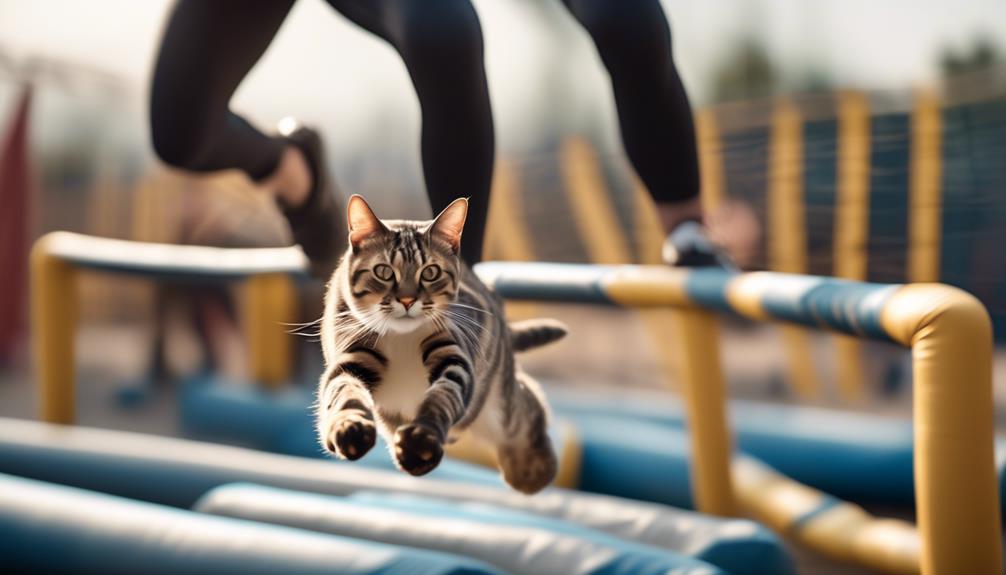Feline agility training has become increasingly popular among cat owners seeking to engage and stimulate their pets. With the unveiling of three tailored training plans, cat enthusiasts can now take their pets' agility to the next level.
Each plan is specifically designed to cater to different skill levels, ensuring that cats of all abilities can benefit from the training. Whether you're a beginner looking to introduce your cat to agility exercises or an experienced trainer seeking advanced challenges, these plans offer a comprehensive approach to feline agility.
Key Takeaways
- Feline agility training plans are divided into beginner, intermediate, and advanced levels.
- The training plans incorporate basic agility exercises, clicker training, and the gradual introduction of hurdles, tunnels, and weave poles.
- Feline behavior is crucial in designing an effective training plan, respecting boundaries and comfort levels, and tailoring the program to each cat's unique personality.
- Feline agility training enhances coordination, balance, physical fitness, mental acuity, problem-solving skills, and strengthens the bond between cat and trainer.
Beginner Feline Agility Training Plan
The beginner feline agility training plan focuses on introducing basic agility exercises to cats in a structured and progressive manner, laying the foundation for more advanced training. Understanding feline behavior is crucial in designing an effective training plan. Cats are known for their independent nature, and it's essential to respect their boundaries and work within their comfort levels.
Clicker training, a widely used positive reinforcement method, can be effectively incorporated into the beginner feline agility training plan. This involves using a clicker to mark the desired behavior and then rewarding the cat with a treat. It helps in creating a positive association with the training process and motivates the cat to engage in the agility exercises.
The beginner plan is designed to gradually introduce cats to simple obstacles such as hurdles, tunnels, and weave poles. These exercises are aimed at enhancing the cat's coordination, balance, and overall physical fitness. It is important to proceed at the cat's pace, ensuring that they are comfortable with each step before progressing to the next. This approach fosters a positive and enriching training experience for both the cat and the trainer.
Intermediate Feline Agility Training Plan
Building upon the foundational exercises of the beginner feline agility training plan, the intermediate plan aims to further develop the agility and skills of cats through more challenging obstacles and advanced training techniques.
Feline agility obstacles in the intermediate plan are designed to enhance speed, coordination, and mental acuity. These obstacles include weave poles, tunnels, and elevated platforms, which encourage cats to refine their movements and make quick decisions while navigating the course.
To improve speed and coordination, advanced techniques such as target training and directional cues are introduced. Target training involves teaching cats to touch a specific spot with their paw or nose, which can be used to guide them through agility courses with precision. Directional cues, such as hand signals or verbal commands, help cats understand where to go and how to maneuver through the obstacles efficiently.
In addition to physical exercises, the intermediate plan also emphasizes mental stimulation to keep cats engaged and focused. This includes incorporating interactive toys and puzzles into training sessions to enhance problem-solving abilities and maintain enthusiasm for agility training.
Advanced Feline Agility Training Plan
Advancing beyond the skills honed in the intermediate level, the advanced feline agility training plan introduces complex challenges and refined techniques to further elevate a cat's agility and mental acuity. Understanding feline behavior is paramount in this advanced stage, as it allows trainers to tailor the program to each cat's unique personality and capabilities.
Training techniques at this level focus on enhancing the cat's ability to navigate intricate obstacle courses with speed and precision, while also emphasizing mental stimulation to keep the feline engaged and motivated.
One advanced training technique involves teaching the cat to respond to increasingly subtle cues, such as hand signals or auditory commands, enhancing their responsiveness and overall performance. Additionally, advanced agility training incorporates advanced obstacles, including tunnels, weave poles, and elevated platforms, to challenge the cat's physical and mental abilities.
These techniques not only promote physical fitness but also stimulate the cat's problem-solving skills and spatial awareness.
Frequently Asked Questions
What Are the Most Common Mistakes Owners Make When Training Their Cats for Agility?
Common mistakes in cat agility training include rushing the process, using punishment, and neglecting individual needs. To improve performance, focus on positive reinforcement, patience, and tailored training techniques. Incorporating bonding exercises also enhances the training experience.
Are There Any Specific Dietary Recommendations for Cats Undergoing Agility Training?
Cats undergoing agility training have specific nutritional requirements to support their exercise routines. Special diets tailored to their agility performance can include high-protein, low-carbohydrate options to enhance muscle strength and endurance during training.
How Can I Incorporate Agility Training Into My Cat's Daily Routine Without It Becoming Overwhelming for Them?
Incorporating play, mental stimulation, indoor obstacle courses, positive reinforcement, and bonding activities are key to integrating agility training into your cat's routine. Gradual introduction, short sessions, and personalized activities can ensure a positive experience.
Are There Any Specific Breeds of Cats That Are More Suited for Agility Training Than Others?
Certain breeds of cats are more inclined towards agility training due to their natural athleticism and high energy levels. Breeds such as Abyssinians, Bengals, and Siamese are known to excel in agility training, while individual feline behavior and temperament also play a significant role in their suitability for agility training.
What Are Some Alternative Methods of Agility Training for Cats Who May Not Respond Well to Traditional Methods?
For cats who may not respond well to traditional agility training methods, alternative options include playful engagement and mental stimulation through bonding activities and interactive games. These methods not only enrich the cat's experience but also strengthen the human-feline bond.


